This Holiday Brisket is one of my more popular brisket recipes for the Jewish holidays. It is inspired by a classic Ashkenazi sweet-and-sour brisket, but the flavors here are more subtle. This brisket is savory, aromatic, and subtly sweet with just a touch of tang. It’s always a crowd pleaser!
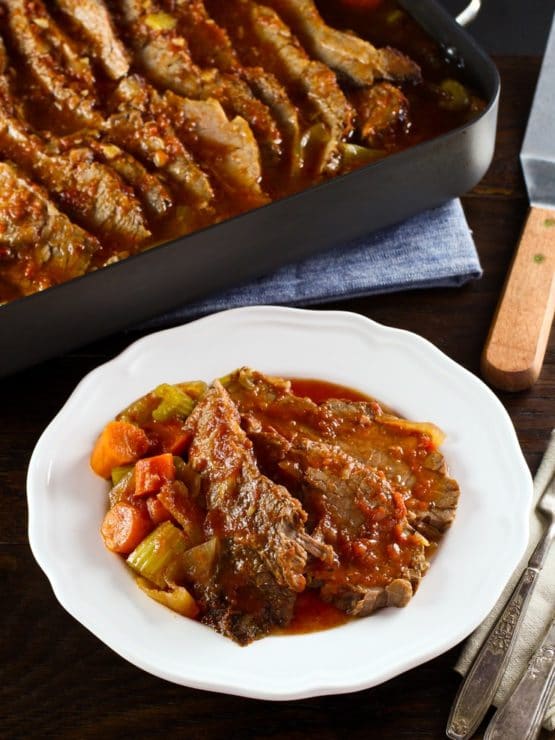
Jews living in Eastern Europe rarely had the money to buy better cuts of meat. They learned to make do with cheaper kosher cuts, like brisket, oft overlooked for its toughness. Cooking the brisket low and slow breaks it down, resulting in a tender piece of meat.
This Jewish tradition continues today, and brisket is often served for special holidays and occasions. On Shabbat, it is added to a pot with vegetables and potatoes to make a slow-cooked meaty stew known as cholent. At Rosh Hashanah, it is added to root vegetables with sweet dried fruits and slow cooked into tzimmes.
When Ashkenazi Jewish immigrants came to the United States, they brought their love of brisket with them. Jewish deli owners pickled the brisket to make corned beef or pastrami. But for the holidays, nothing could replace the comforting, hearty flavor of an oven-roasted brisket.
How to make brisket tender
The secret to a cooking brisket is twofold– brisket fat and time are key for tender and delicious results. Choose a cut with nice marbling; the more fat you can see, the more tender the meat will be. If buying grass fed (which tends to be leaner), make sure there is a fat layer and don’t let the butcher trim it. And of course, allow yourself plenty of time to cook your brisket. If you can, make it a day or two ahead– the flavor will improve with time. More tips here: How to Cook Brisket – Tips and Recipes
My Holiday Brisket slow cooks for hours, so the final product flakes tenderly and simply melts in your mouth. The sauce is rich and flavorful, and the slow cooked vegetables are soft, like butter. The flavor is perfect for any special celebration, but particularly suited to the Jewish holidays. Enjoy!
What is traditionally served with Brisket?
Olive Oil Mashed Potatoes with Garlic and Rosemary
Roasted Rosemary Balsamic Tzimmes
Butternut Squash and Crispy Kale Bake
Green Beans with Balsamic Date Reduction Feta and Pine Nuts
Kale and Roasted Beet Salad with Maple Balsamic Dressing
Throwback Recording: In this radio interview with Joan Hamburg, we talked about this very brisket recipe, as well as Passover cooking. You can listen by clicking the triangle “play” button below.
Recommended Products:
We are a participant in the Amazon Services LLC Associates Program, an affiliate advertising program designed to provide a means for us to earn fees by linking to Amazon.com and affiliated sites. As an Amazon Associate I earn from qualifying purchases.
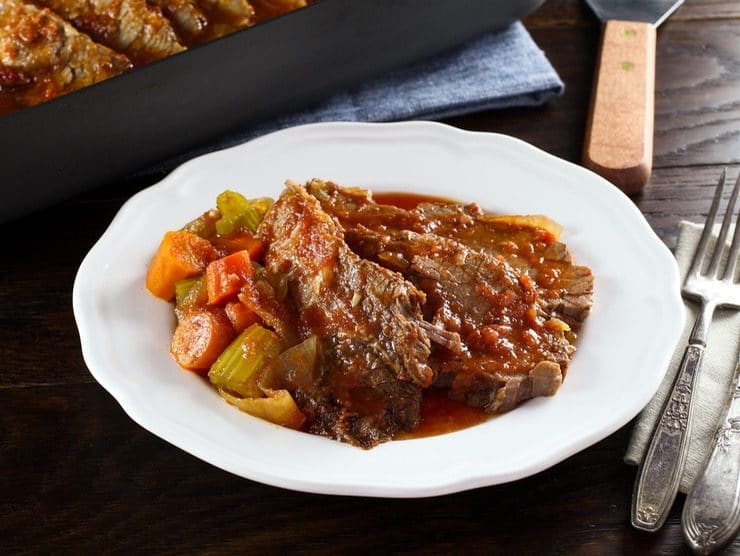
Food Photography and Styling by Kelly Jaggers
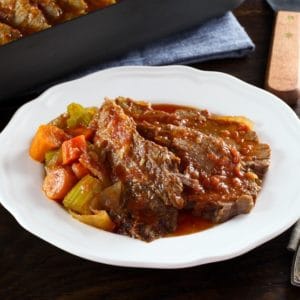
Holiday Brisket
Ingredients
- 5-7 pounds brisket, first or second cut (do not trim fat - especially if it's grass fed)
- 1/4 cup extra virgin olive oil, divided
- 2 large brown onions, peeled and sliced
- 1 pound carrots, peeled and sliced
- 1 pound celery, peeled and sliced
- 28 ounces tomatoes - whole, diced, or crushed (1 large can)
- 10 peeled whole garlic cloves
- 1/2 cup brown sugar
- 1/4 cup vinegar (I like apple cider vinegar, but white vinegar works too)
- 2 cups beef or chicken broth, divided
- Salt and pepper
NOTES
Instructions
- Preheat oven to 300 degrees F. Rinse the brisket and pat dry. Rub both sides of the meat with black pepper and salt. Heat a large skillet over a medium flame on the stovetop. Drizzle 2 tbsp of olive oil into the pan. Brown the brisket on both sides—it will take 4-5 minutes per side. A large brisket may overlap the edges of the skillet; you can brown it in stages, letting half the brisket overlap the edge, then adjusting it to brown the other half.

- While brisket is browning, pour canned tomatoes, garlic, brown sugar, apple cider vinegar, and 1 ½ cups broth into a blender or food processor. Add 2 tsp of salt (or 1 tsp if using a salted kosher cut of brisket) and ¼ tsp of black pepper. Pulse till garlic is chopped small and all ingredients are combined.

- Remove the browned brisket from the skillet.

- Drizzle 2 tbsp more olive oil in the pan and add the sliced onions. Saute them over medium high for a few minutes until they begin to soften and shrink in size.

- Add the carrot and celery slices. Sauté for another 5-6 minutes until the onions are soft and browning and the vegetables are fragrant.

- Pour the vegetables out of the skillet and onto a plate, reserve. Add 1/2 cup beef stock or chicken stock into the skillet and let it heat up. Use a spatula to gently scrape up any brown bits and pan juices that are clinging to the skillet. Turn off heat.

- Pour half of the tomato mixture into a large roasting pan.

- Place brisket on top of the tomato sauce, fat cap facing up.

- Pour the sauteed vegetables across the top of the brisket, along with the broth and brown bits.

- Pour the remaining tomato sauce over the top of the vegetables and brisket.

- Cover the roasting pan tightly with a layer of parchment paper followed by a layer of foil. The parchment forms a protective layer between the meat and sauce (which is acidic) and the foil.

- Place brisket in the oven. Let it roast undisturbed for 5 to 7 hours. It will take about 1 hour per pound of meat (leaner cuts of meat like grass fed may take longer—test for doneness). Brisket is ready when it flakes tenderly when pierced with a fork. You can let it cook even longer for a soft, shredded texture if that’s what you prefer. When fully cooked, the brisket will have shrunk in size.I recommend making this brisket ahead; allowing it to sit in the refrigerator for 1-2 nights will improve the flavor. If you would like to do this, skip ahead to where it says “Make Ahead Directions.” If you are not making ahead, continue reading.

- Remove brisket from the pan and let it rest on the cutting board fat-side up for 20-30 minutes. Meanwhile, pour the sauce and vegetables from the roasting pan into a smaller saucepan. Skim fat from the surface of the cooking sauce, then reheat the sauce till hot (not boiling).Cut fat cap off the brisket, then cut the brisket in thin slices against the grain. Serve topped with hot tomato sauce and softened veggies.

- Make Ahead Directions: Open the foil to vent and let the brisket slowly return to room temperature. Switch the brisket and sauce to a ceramic or glass dish (metal from the roasting pan can react with the acid in the sauce, which can cause an off taste if left to sit). Cover with plastic wrap and place in the refrigerator. Let the brisket chill overnight, or up to two days. You can also freeze the brisket if you prefer.

- 1-2 hours before serving, remove the brisket from the refrigerator and preheat your oven to 350 degrees F. The fat in the sauce will have risen to the top, turned white, and solidified. Use a spoon to scoop the fat bits out of the sauce and discard.

- Take the brisket out of the dish and brush any excess sauce back into the dish. Place brisket on a cutting board, fat-side up. Slice the meat cold—first cut the fat cap off the brisket, then cut the brisket in thin slices against the grain.

- Return the sliced meat to the dish and spoon sauce over it, making sure to spoon a little sauce between each slice. Cover the dish with a layer of parchment paper, then with foil, and place it in the oven.

- Let the brisket roast for 45-60 minutes until heated through. You can cook the brisket even longer to let it become more tender, if you wish. Serve with hot sauce and softened veggies. If you prefer, you can use a slow cooker to reheat. Set the slow cooker to high heat and cook until heated through, about 1 hour.

Nutrition

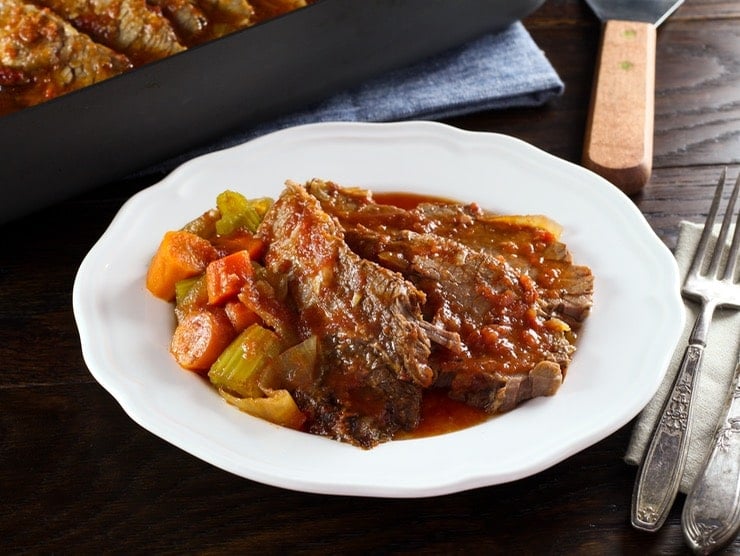
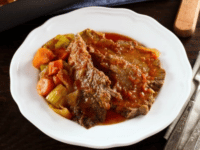
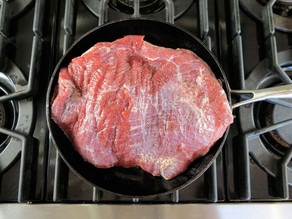
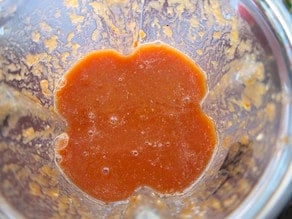
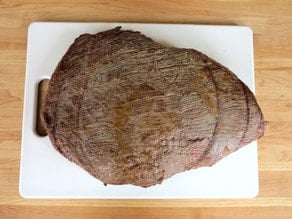
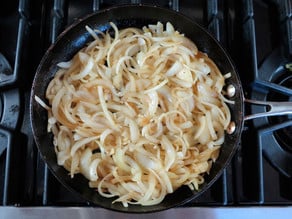
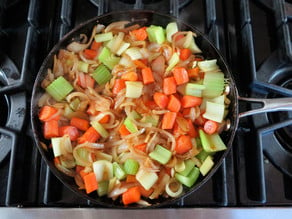
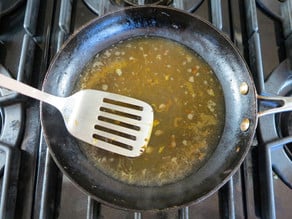
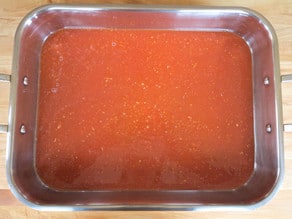
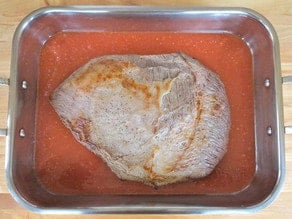
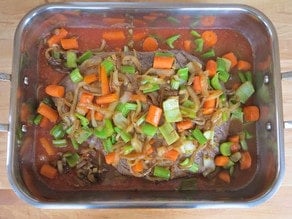
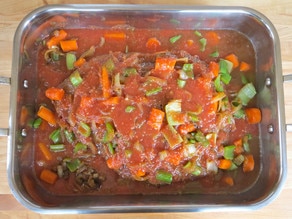
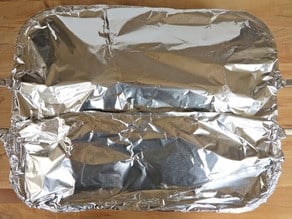
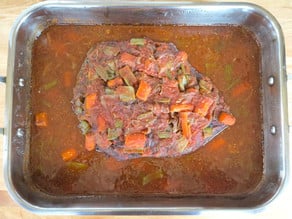
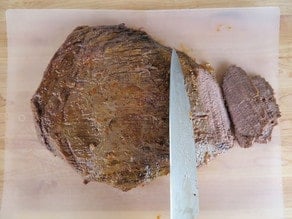
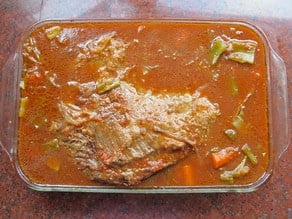
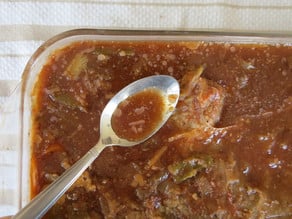
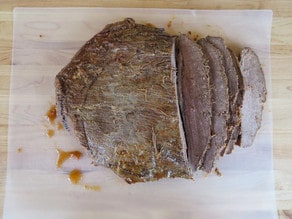
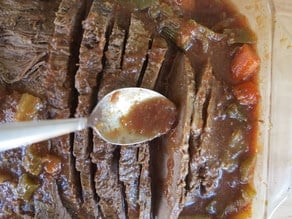
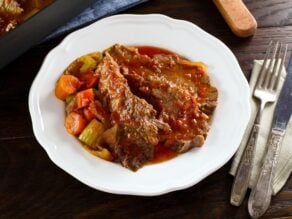


Made this for the first time but for the reheat there is very little sauce concerned it will dry out
You can add water or low sodium stock to the sauce to stretch it. If it seems too thin, add a touch of cold water mixed with potato starch or corn starch to thicken.
Hi
Can you slice cooked meat and pour sauce over and let it sit in the refrigerator for 2 days instead of slicing the day you want to use it?
Yes.
I discovered this recipe a few years ago. It is my holiday go-to. Everyone, and I mean everyone, LOVES it. Even the ones who say they don’t like carrots and celery, the ones who say they don’t love onions, the ones who say they don’t like tomato-based briskets. The sauce is the perfect blend of tangy and savory, a great balance between tomato-based and onion-centric recipes. My father especially loved it. He passed away a day before Passover in 2022. We didn’t have a full seder in our grief, but I did go ahead and make the meal. There was something so comforting about enjoying this comfort food-it felt like family, and we ended up laughing and sharing dad stories over the meal, instead of silently and sadly eating something we just ordered from a restaurant. Sorry – that got sappy. Point is … this is the best brisket recipe I’ve ever tried, and it’ll end up becoming a holiday tradition that instantly reminds you of family.
I made this brisket for Passover and everyone loved it. I never made a brisket before so I was a bit nervous. I appreciated this recipe because it felt more natural than using onion soup mix. I prefer more natural seasonings. Thank you so much for this recipe and for satisfying my family and friends with a delicious meal.
I’m trying something new. On serious eats, there’s an excellent recipe for sous-vide brisket that I’ve done multiple times. There are two temperatures that they use, 135 and 150. The 135 72 hour method is the one I prefer, as it yields an incredibly tender, but still steak-like brisket slice that doesn’t completely fall apart.
I’ve decided to do a hybrid where I separately sous-vide the brisket, but instead of smoking it after, I’m going to do it up as my mom would traditionally braise for the holidays. I just seasoned the brisket in the sous-vide with salt, pepper, onion, and a little brown sugar.
I plan on pulling it out, cooling it all the way, slicing, and adding to some version of your braise (which I’ve made and love).
The sous-vide bag will have a significant amount of juice that I’d like to use (it’s a 6.5 pound point, fat intact). How would you go about using the juice and separately cooking a braising liquid that I can then add the sliced brisket back into to serve, for a sort of hybrid sous-vide perfect meat with but still served in the flavorful long-cooked braising liquid? I haven’t seen anyone attempt a sous-vide Jewish style brisket yet, but this was what I came up with. Thanks so much!!!!
I am making this for Passover this year and want to simplify my menu. I am doing the making ahead method.
1. The vegetables: are they more as a garnish and for taste in the sauce, or can I use them as a side dish? Do they retain any texture or do they get too soft for that?
2. Can I add potatoes too the last hour or two so I have roast potatoes as another side? What happens when you reheat it with the potatoes?
3. I am making this in a large Le Creuset dutch oven. Do I still need to do the parchment?
Hope to hear back before Passover! Thanks!
Hi Maxine! The veggies really get soft with the long, slow cooking… they’re great for flavoring the sauce, but won’t really work as a stand alone side. Potatoes may soak up the cooking liquid, which will leave you with less sauce… if it were me I would probably roast the potatoes on a separate tray. But if you want to cook it together, just make sure you keep an eye on the liquid levels and add liquid (low sodium broth would be best) as needed. No need for the parchment or foil if you have a covered dutch oven. Enjoy!
I make this brisket every year and it’s always a hit. I’ve had good luck with both flat and point cuts of brisket and I use duck fat for the veggies. I hate to say it but this is better than my grandma’s recipe!
This was phenomenal, and my first time making it. It was like bringing back my Jewish grandmother’s amazing cooking. I have asked people for their brisket recipes in the past, and when they say things like Lipton French Onion Soup, Coca Cola and ketchup. I didn’t want this. I wanted real food, and this recipe is perfect. The house smelled so good, too.
First time making a holiday brisket in over 20 years. Very good recipe and instructions. I made 2 small changes: added 3 medium red potatoes (cubed) and a cup of frozen peas to the veggie mix, and instead of beef broth I used beef stock (a bit deeper/richer flavor). Everyone raved about the meal. Thanks for posting your recipe.
First time making brisket. It was fabulous! Smallest I was able to find was 7.7 pounds. Had to fold over and move around to brown it. Be careful when doing so due to hot oil. I was afraid to cut the brisket to a smaller size because I didn’t want to ruin anything.
This is my second Passover using this recipe and it won’t be my last. So tender and good!! Always make it a day or 2 ahead of time and enjoy!
First time using this recipe. Bought a whole 12# brisket at Kroger for $1.97 per pound! Making the flat for Passover and will save the point for BBQ later this summer. I have my mother’s Magnalite covered roaster from the 1950’s, but was afraid to use it because of the possible interaction with the tomato sauce. Is there a safe way that I could use the roaster? Did this year’s in a glass pan but would like to remember my mom by using her pan. Brisket is in the fridge waiting for dinner tomorrow.
The roasting pan will be just fine for the cooking portion, but I wouldn’t keep it stored in there due to the acidity in the sauce. Enjoy!
Hi Tory,
If using an enamel, porcelain on steel roaster, do I still to cover the pan with a layer of parchment paper followed by a layer of foil or can I do without the parchment and foil layers?
If the roaster has a lid, no need to cover it with parchment/foil.
Hello. I’m making this brisket on a Monday and serving Fri. I’m guessing I have to freeze it, but I don’t see instructions for freezing. It says you can freeze if you prefer, but ca I freeze it in the pan I’ll reheat it in covered with plastic wrap or do I freeze it in something else? Also, since you slice it cold, do I put it in the fridge to defrost a day before, then slice, then reheat? Thanks!